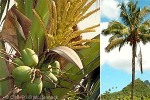Cook Islands Biodiversity Database
Species Page
Cocos nucifera
Nū / Tumu-NūCoconut Palm
Multimedia & Additional Resources
| Type | Description | Download |
| Palms, fruit, flowers and leave | 70KB | |
| Seven palms from one nut (Rarotonga, Aitutaki) | 78KB | |
| Rarotonga - corkscrewed trunk | 57KB | |
| The face on a coconut shell | 59KB | |
| Seven Palms from One Coconut? Gerald McCormack, December 2005 |
Read | |
| The Origin of the Coconut Palm Gerald McCormack, September 2005 |
Read |
General Information
Cook Islands Distribution
| Southern Group: Present Makatea: Present | ||||||||
RR |
MG |
AT |
MK |
MT |
AK |
PL |
TK |
MN |
++++ |
++++ |
++++ |
++++ |
++++ |
++++ |
P |
P |
PW |
| Northern Group: Present | |||||
TN |
MH |
RK |
PK |
NS |
SW |
++++ |
P |
P |
++++ |
P |
P |
Pests & Hosts
| Relationship | Pests |
| Herbivorous pest | Erechthias sphenacma, |
Scientific Taxonomy
Cocos nucifera Linnaeus
TAXONOMY: PLANTAE; ANTHOPHYTA (=Angiospermae); LILIOPSIDA (=Monocotyledones); ARECIDAE; Arecales; ARECACEAE
More Information
SIGNIFICANCE NOTES -. Comment: NBSAP - Mauke (Nū Pokura & Kere, 4 of 9 domestic plants)
POSITIVE SIGNIFICANCE: Medicine, Ornamental leaves, Food (Fruit 4+),Material (Fibre, Wood). Comments: MATERIAL: Old wood from base hard, lasts well. Brown with black striping. Difficult to work due to tough fibres.
IDENTIFICATION: Long-lived, to c.100years, solitary palm to 30m. TRUNK column-like, unbranched, slightly curved, to 30cmØ, thicker at base. LEAVES in spiral terminal cluster of 10-20 leaves, each a frond to 5x2m, basal sheath a fibrous gauze; midrib with two rows of leaflets forming one plane; develop 12-14 leaves a year. LEAFLETS (=pinnae, segments), numerous, 1-ribbed, stiff, swordlike, to 80x8cm. FLOWERS simple-branched cluster, to 1m, at base of the leaves; female flowers singular at base of each branch, 3cmØ; male flowers, small, very numerous (200-300) along the branches, fall before female flowers open; cross-pollination by insects and wind; spathe (=bract) large, woody, narrow-oval, spits along underside. FRUIT large to 2kg, ovoid, to 35x25cm, skin (exocarp) ripening green, yellow or orange; husk (mesocarp) thick and fibrous, shell (endocarp) thin, hard, with 3 pores ('eyes') including one over the embryo; SEED large, embryo at base; endosperm (=flesh), 1-2cm, white, solid, oily, with central cavity of water. The ovary has 3 ovules assocaited with three pores in the shell, two abort and one develops.
GENERAL NOTE: The evidence that the Coconut Palm is native in the South Pacific to at least the Cook Islands is from Atiu and Mangaia. On Atiu coconut pollen is found in the pollen record at 8600BP (corrected date), which is several thousand years before the first Polynesian settlers arrived [Parkes 1997]. On Mangaia Coconut and Indian Mulberry are in the pollen record at 7300B.P. and the earliest dispurbance that might have been human-induced is at 2500BP [Ellison 1994]. On Moorea it is found at 1400BP when the settlement seems to have occurred around 1200BP [Parkes 1997].
The world's main source of vegetable fat, obtained from the dried flesh (endosperm). Husk provides fibre (coir).
Vouchers & References
Vouchers:
Pukapuka: fieldspecimen, 2/2004, G.McCormack with ID as Cocos nucifera.
References:
p.1362 Wagner et al.- Flowering Plants of Hawaii
p.119 Neal - In Gardens of Hawaii
p.291 Hortus 3rd
p.769 Tropica
p.1/437 A.C.Smith - Flora Vitiensis Nova
p.300 I Cheeseman - Flora of Rarotonga
p.24 ? Wilder - Flora of Rarotonga
p.383e Whistler - Ethnobotany of the Cook Islands
Data Update History (information):
zTX, zB02, zM02, zupB04b, zD02
Web Resources
Citation Information
McCormack, Gerald (2007) Cook Islands Biodiversity Database, Version 2007.2. Cook Islands Natural Heritage Trust, Rarotonga. Online at http://cookislands.bishopmuseum.org. ![]()
Please refer to our use policy.

